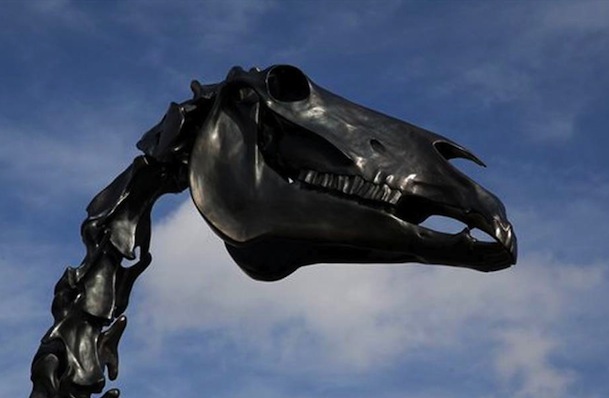The unveiling of the Fourth Plinth has, since his election to office, been an opportunity for Mayor Boris Johnson to work the press pen with a comic turn. So, the commission, sponsored by the mayoral office, gets a media-chummy spokesperson whose art critiques add a note of gaiety to proceedings, even if they’re self-evidently at odds with what the artist had in mind. See them as an ongoing election campaign.
Hans Haacke’s Gift Horse, which was unveiled yesterday, is a larger than life-size bronze skeleton of a horse, modelled on an anatomic etching by George Stubbs, the 18th-century English artist of thoroughbreds whose majestic Whistlejacket hangs in the National Gallery just behind it.
It might still be standing, but this horse is well past flogging
Tied to the foreleg of Haacke’s horse, which the ghastly carcass proffers to passersby as if gift-wrapped, is an LED ribbon displaying the live ticker for the London Stock Exchange. The work clearly isn’t, as Boris jested in a somewhat baroque speech, about regeneration under the Tory coalition ho ho, but that’s hardly what one would expect from an artist known for his institutional critiques, one who has consistently highlighted the relationship between art, money and power and set about exposing the nefarious dealings of the ruling cultural institutions that determine an art work’s cultural worth.
Institutional critiques can be a little dry and hermetic, but we can all get what Haacke is on about in this far more public arena. Gift Horse is a fitting work for the age of austerity, and one which signals the role of the bankers in bringing us to our knees. It is a work of striking wit and irony, even if the ironies seem a little leaden and whose layers are not in the least opaque. That it has been erected in a square that celebrates Empire, with Francis Chantrey’s virile George IV mounted on a powerful horse, offers us a stark contrast between the pomp of then and the pimped of now – a contrast that depicts UK plc as a knackered institute at the mercy of the City. It might still be standing, but this horse is well past flogging.










![SEX MONEY RACE RELIGION [2016] by Gilbert and George. Installation shot of Gilbert & George 21ST CENTURY PICTURES Hayward Gallery](/sites/default/files/styles/thumbnail_125_x_125_/public/mastimages/Gilbert%20%26%20George_%2021ST%20CENTURY%20PICTURES.%20SEX%20MONEY%20RACE%20RELIGION%20%5B2016%5D.%20Photo_%20Mark%20Blower.%20Courtesy%20of%20the%20Gilbert%20%26%20George%20and%20the%20Hayward%20Gallery._0.jpg?itok=3oW-Y84i)





Add comment